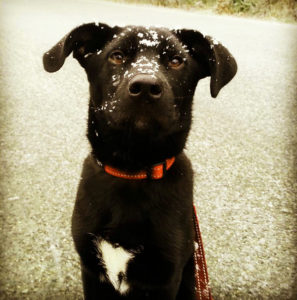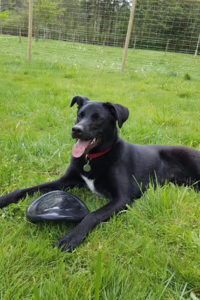In September of 2015 we adopted a sweet little 8 week old puppy from the Comox SPCA, one of five in a litter that was taken from a reserve in Bella Bella. The mother was spayed and returned, and the pups were offered for adoption. Four of the five were black with white markings and one was brown, black and white. Thinking that they were primarily Labrador retrievers, the SPCA staff named them all for characters in Newfoundland folk songs. Our pup was Molly.
I have learned many things from this experience, and one of them is that all puppies look pretty much the same. They’re cute, chubby and playful, their sweet puppy appearance offering pretty much no indication of what their eventual dog appearance and disposition will be. This was true for Molly. As a puppy, she looked very much like a black lab, and she had an innate ability to retrieve. She also had the lab propensity for eating everything in sight. She has webbed feet and a thick woolly undercoat.

But as she grew, she began looking less and less like a Labrador. Her head became fine, her body slim and streamlined, and her legs continued to grow longer and longer. And longer. She never showed an interest in water, and when we tried to swim with her she actually revealed an aversion to it, no matter how fun the game or enticing the toy. In her training classes, Molly learned much more quickly than most of the other dogs, showing an intense drive for work. She passed her Novice Trick Dog exam easily, and quickly met all of the criteria for the Intermediate Trick title as well.
Her energy is boundless, her running speed is incredible…and she’s still getting taller. People often ask us what breed of dog she is, and we say Lab-Gorilla Cross, or Premium Northern Blend. Most often she is identified as a Lab, but I suspect that this wouldn’t happen nearly as much if she wasn’t black in colour, because there is much about her that simply isn’t Lab at all.
 Her genetic history really continues to be a mystery, and for many reasons we thought that it would be great to know where she came from. Knowing exactly what breeds are dominant in her genetics would help explain her better. Dogs’ drives are quite specific to their breeds, and knowing what instinctively drives a dog helps to fulfill their dog-ness, making it much easier to work with them effectively.
Her genetic history really continues to be a mystery, and for many reasons we thought that it would be great to know where she came from. Knowing exactly what breeds are dominant in her genetics would help explain her better. Dogs’ drives are quite specific to their breeds, and knowing what instinctively drives a dog helps to fulfill their dog-ness, making it much easier to work with them effectively.
She might be a Lab-German Shepherd, or a German Shepherd-Pit Bull, or a Lab-Boxer. Or she might be something else entirely. The great thing is that we’re going to find out soon! Today, I ordered the Mars Veterinary Wisdom Panel, an in-depth DNA panel that compares the dog’s DNA against over 250 recognized breeds of dogs from around the world to identify the its breed history. A family tree of several generations is possible, and the test also screens for genetic markers of common health issues.
Behind the Science
To provide accurate breed detection results you need three things: a large breed database, a sophisticated algorithm and a significant number of markers strategically placed across the genome. Wisdom Panel features the largest breed database of over 250 breed, types and varieties represented in more than 12,000 samples. We examine your dog’s DNA at 1800+ points (markers) and send the data to a computer that evaluates them using an advanced algorithm and more than 18MM calculations. The algorithm uses information from our extensive sample database to analyze your dog’s potential pedigree trees going back three generations. After giving each of the millions of possible combinations a score based on how well it matches your dog’s data, the computer selects the tree with the overall best score and that is what is reported in your dog’s results.
What kind of dog do you think Molly is? All will be revealed in a few short weeks.
Wait and see!
